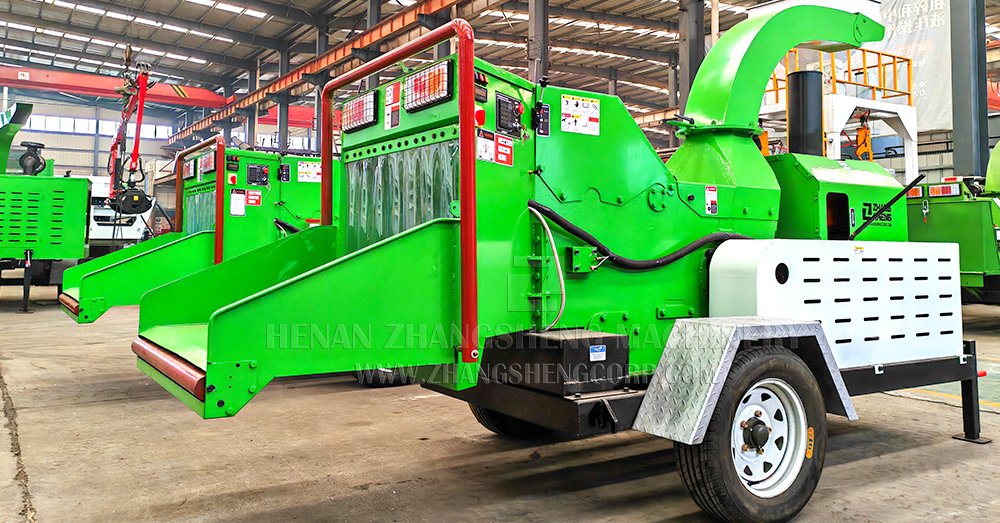Chipping big logs seems like a tough job, and you might worry about safety. If you don't know your machine or the rules, it can be risky, leading to accidents or damage.
Yes, it is generally safe to put logs into a wood chipper if the chipper is specifically designed for logs, the log's size is within the machine's stated capacity, and you follow all safety operating procedures strictly.
These powerful machines can make quick work of logs, saving a lot of time and effort. But understanding how to do it safely is key. Let's look deeper into how you can chip logs without putting yourself or your equipment at risk. This knowledge will help you work with confidence.
Can you put logs into a wood chipper?
You have some logs and a wood chipper, but are they a good match? Putting a large log into a small chipper can cause big problems, like breaking the machine or even causing injury.
You can put logs into a wood chipper, but only if that specific chipper model is built to handle the size and type of logs you have. Always check the manufacturer's specifications first.
In my 22 years of experience in manufacturing wood chippers, I've learned that not all chippers are created equal. Some smaller machines are great for branches and brush, but they just don't have the power or the infeed opening for actual logs. Trying to force a log into one of these is asking for trouble. Our company, TIROX, designs a range of chippers, and our larger models are definitely built for logs. They have powerful engines and robust cutting systems. For example, a chipper needs a strong hydraulic feed system to pull logs in steadily and safely. You can't just push a heavy log; the machine needs to do the work. The maximum diameter a chipper can take is also a very important number. If a log is too thick, it will jam the machine or overload the engine. I once saw a customer try to feed an oversized log into a chipper not rated for it. The machine stalled, and it took a lot of effort to clear it safely. It’s much better to cut the log down to size first.
Key Factors for Chipping Logs Safely:
Chipper Design and Power:
Is the chipper a heavy-duty model intended for logs, or a lighter unit for branches?
Does it have a powerful engine (diesel is common for log chippers) sufficient to cut through dense wood?
What is the maximum log diameter specified by the manufacturer? Never exceed this.
Infeed System:
A good log chipper usually has a hydraulic infeed system. These rollers grip the log and pull it into the cutting mechanism at a controlled rate.
Look for features like an emergency stop bar or reverse feed, which are crucial for safety.
Log Condition:
The log should be relatively clean, without stones, metal, or excessive dirt, which can damage blades or become dangerous projectiles.
Very knotty or oddly shaped logs can sometimes be more difficult to feed.
Here's a simple way to think about it:
| Feature | Small Brush Chipper | Large Log Chipper | Why it Matters for Logs? |
|---|---|---|---|
| Max Diameter | Usually under 4-6 inches | Can be 8 inches, 12 inches, or more | Must match or exceed your log diameter. |
| Engine Power | Lower HP (e.g., 10-50 HP) | Higher HP (e.g., 50-200+ HP) | Needed to cut through dense log material. |
| Infeed System | Gravity or light power feed | Hydraulic forced feed | Provides controlled, powerful feeding of heavy logs. |
| Overall Build | Lighter construction | Heavy-duty, robust construction | Withstands the stress of processing logs. |
Always check your machine's manual before attempting to chip logs. If you're unsure, it's better to ask the manufacturer or err on the side of caution.

What not to put in a wood chipper?
You might think your wood chipper can eat anything, but that's a dangerous idea. Feeding the wrong things into it can break your expensive machine or, worse, send dangerous bits flying.
Never put anything other than clean wood into a wood chipper. Items like metal, stones, plastic, glass, or wood contaminated with these materials are strictly off-limits due to high risk of damage and injury.
As a manufacturer, we design wood chippers to process wood and woody biomass efficiently. Their cutting systems, whether blades or hammers, are engineered for organic material. I cannot stress enough how important it is to avoid feeding them foreign objects. I recall a case where a customer tried to chip old pallets without removing all the nails. The nails shattered a blade, and a piece of metal shot out of the discharge chute with incredible force. Luckily, no one was hurt, but it was a very close call and an expensive repair. Even things like dirt and small stones mixed with wood can rapidly dull the blades, making the chipper less effective and increasing the strain on the engine. Treated wood, like old railway sleepers or some construction timber, can also be problematic as it might release harmful chemicals when chipped. It's always best to stick to clean, untreated wood.
Absolutely Do Not Chip These:
Metal:
Includes: Nails, screws, bolts, wire, tools, cans.
Why: Can shatter blades, become high-speed projectiles, cause sparks (fire hazard).
Stones, Rocks, Concrete, Bricks:
Why: Will break or severely damage blades/hammers, can be ejected forcefully.
Plastics:
Includes: Bottles, bags, containers, toys.
Why: Can melt and wrap around moving parts, create fumes, or shatter into sharp pieces.
Glass:
Why: Shatters into countless sharp fragments that can be thrown out or contaminate chips.
Rubber:
Includes: Hoses, tires.
Why: Can wrap around components, melt, or be difficult for the chipper to process.
Pressure-Treated Wood (some types):
Why: Older treated wood (especially with CCA - chromated copper arsenate) can release toxic dust and ash if chips are burned. Check local regulations.
Large amounts of soil or dirt:
Why: Extremely abrasive to blades, dulling them quickly.
Stringy materials like fabric, rope, or vines (in large, unmixed quantities):
Why: Can wrap around the drum or feed rollers, causing jams.
Think of it this way:
| Material | Primary Risk | Consequence for Chipper | Consequence for Operator |
|---|---|---|---|
| Metal | Projectile, Blade Damage | Severe damage, costly repair | Serious injury risk |
| Stones/Concrete | Projectile, Blade Damage | Severe damage, costly repair | Serious injury risk |
| Hard Plastics | Shattering, Projectile | Potential internal damage | Injury from fragments |
| Soft Plastics/Rubber | Melting, Wrapping | Clogging, damage to bearings | Burns (if hot), downtime |
Always inspect the wood you plan to chip. If it's dirty, clean it. If it has metal, remove it. Your safety and the machine's lifespan depend on it.


